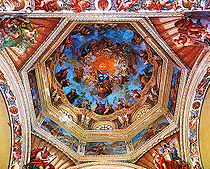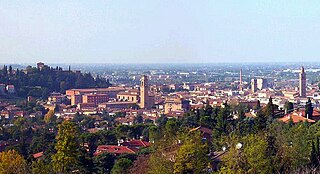
Cesena is a city and comune in the Emilia-Romagna region of Italy, served by Autostrada A14, and located near the Apennine Mountains, about 15 kilometres from the Adriatic Sea. The total population is 97,137.
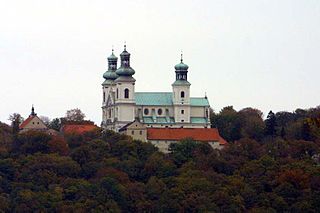
The Camaldolese Hermits of Mount Corona, commonly called Camaldolese is a monastic order of Pontifical Right for men founded by Saint Romuald. Its name is derived from the Holy Hermitage of Camaldoli, high in the mountains of central Italy, near the city of Arezzo. Its members add the nominal letters E.C.M.C. after their names to indicate their membership in the congregation. Apart from the Roman Catholic monasteries, in recent times ecumenical Christian hermitages with a Camaldolese spirituality have arisen as well.

The Benedictine Confederation of the Order of Saint Benedict is the international governing body of the Order of Saint Benedict.

Nonantola Abbey, dedicated to Saint Sylvester, is a former Benedictine monastery and prelature nullius in the commune of Nonantola, c. 10 km north-east of Modena, in the Emilia Romagna region of Italy. The abbey church remains as a basilica and is the co-cathedral of the diocese of Modena-Nonantola.
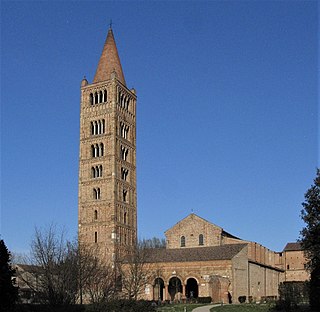
Pomposa Abbey is a Benedictine monastery in the comune of Codigoro on the Adriatic coast near Ferrara, Italy. It was one of the most important in northern Italy, famous for the Carolingian manuscripts preserved in its rich library, one of the wealthiest of Carolingian repositories, and for the Romanesque buildings.

Casamari Abbey is a Cistercian abbey in the Province of Frosinone, Lazio, Italy, about 10 kilometers east-south-east of Veroli.
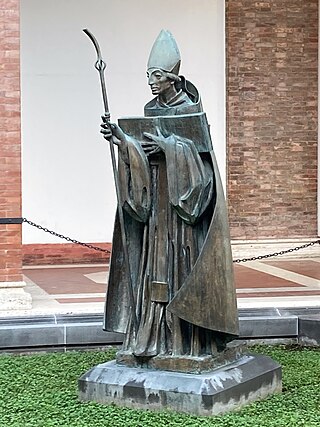
Sant'Anselmo all'Aventino is a complex located on the Piazza Cavalieri di Malta Square on the Aventine Hill in Rome's Ripa rione and overseen by the Benedictine Confederation and the Abbot Primate. The Sant'Anselmo complex, also known as the "Primatial Abbey of Sant'Anselmo" because it is the residence of the Abbot Primate, consists of: an ecclesiastical residential college known as the "College of Sant'Anselmo" ; a university known as the "Pontifical Athenaeum of Saint Anselm" ; the "Church of Sant'Anselmo" ; and the curial headquarters of the "Benedictine Confederation" and Abbot Primate. The complex and associated institutions are named in honor of the Benedictine monk Saint Anselm of Canterbury.

The Abbey of Sant'Antimo, Italian: Abbazia di Sant'Antimo, is a former Benedictine monastery located in Castelnuovo dell'Abate, in the comune of Montalcino, Tuscany, central Italy. It is approximately 10 km from Montalcino about 9 km from the Via Francigena, the pilgrim route to Rome. After many years of disuse, the abbey was reoccupied in 1992 by a small community of Premonstratensian Canons Regular. Since January 2016, the occupants are a community of monks of the Olivetan Benedictine order.
The Subiaco Cassinese Congregation is an international union of Benedictine houses within the Benedictine Confederation. It developed from the Subiaco Congregation, which was formed in 1867 through the initiative of Dom Pietro Casaretto, O.S.B., as a reform of the way of life of monasteries of the Cassinese Congregation, formed in 1408, toward a stricter contemplative observance, and received final approval in 1872 by Pope Pius IX. After discussions between the two congregations at the start of the 21st century, approval was given by Pope Benedict XVI in 2013 for the incorporation of the Cassinese Congregation into its offshoot, the Subiaco Congregation. The expanded congregation was given this new name.

The Abbey of Saint Scholastica, also known as Subiaco Abbey, is located just outside the town of Subiaco in the Province of Rome, Region of Lazio, Italy; and is still an active Benedictine abbey, territorial abbey, first founded in the 6th century AD by Saint Benedict of Nursia. It was in one of the Subiaco caves that Benedict made his first hermitage. The monastery today gives its name to the Subiaco Congregation, a grouping of monasteries worldwide that makes up part of the Order of Saint Benedict.

San Giovanni Evangelista is a church in Parma, northern Italy, part of a complex also including a Benedictine convent and the San Giovanni Old pharmacy.
Ludovico Barbo, O.S.B. (1381–1443), also referred to as Luigi Barbo, was a significant figure in the movement to reform monastic life in northern Italy during the 15th century. Originally a canon of the community which became the Canons Regular of San Giorgio in Alga, he died a Benedictine abbot and Bishop of Treviso (1437–1443).

The Abbey of Santa Giustina is a 10th-century Benedictine abbey complex located in front of the Prato della Valle in central Padua, region of Veneto, Italy. Adjacent to the former monastery is the basilica church of Santa Giustina, initially built in the 6th century, but whose present form derives from a 17th-century reconstruction.

The Palazzo Ghini is a palace of the aristocratic Ghini family in Cesena, Italy. Located in Corso Sozzi, it is the best known of the five palaces of the same family. Its location in the old center of Cesena has been the site of many archeological finds indicating that several Roman buildings stood there in the 3rd–2nd centuries BC.
The Canons Regular of San Giorgio in Alga were a congregation of canons regular which was influential in the reform movement of monastic life in northern Italy during the 15th and 16th centuries.
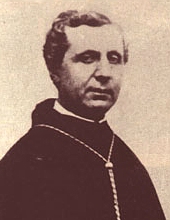
Pietro Casaretto, O.S.B. (1810-1878) was an Italian Benedictine monk who established the Subiaco Congregation, an international federation of Benedictine monasteries, now part of the Subiaco Cassinese Congregation.

Praglia Abbey is a Benedictine monastery in the frazione of Bresseo in Teolo, Province of Padua, Italy. It is located at the foot of the Euganean Hills, some 12 kilometers southwest of Padua, and four kilometers from Abano Terme.

The Abbey of San Pietro al Monte is an small medieval monastic complex mostly dating to the 11th century, in Lombard Romanesque style, on a hill outside the town of Civate, province of Lecco, in northern Italy.

The Basilica of Santissimo Salvatore is a Roman Catholic church in Pavia, region of Lombardy, Italy. It was founded in 657 by the Lombard king Aripert I and became a mausoleum for many of the Lombard kings.

The abbey of Leno, or Badia leonense, was an ancient Benedictine monastic complex founded in 758 by the Lombard king Desiderius in the territory of the present-day town of Leno, in the Lower Brescian region. Demolished at the behest of the Venetian Republic in 1783, today only stone fragments of the ancient abbey remain, largely preserved in the Brescian museum of Santa Giulia, while burial mounds were found on site as a result of archaeological excavations held in 2003 by the Superintendence for Archaeological Heritage of Lombardy.

